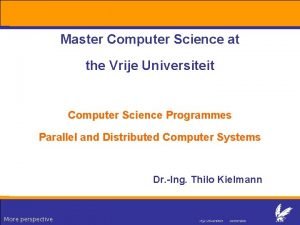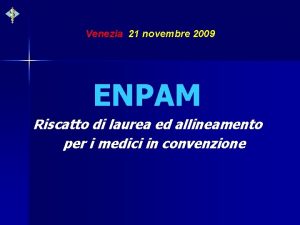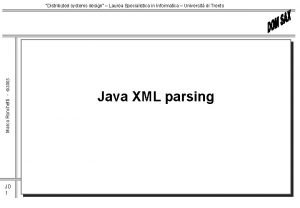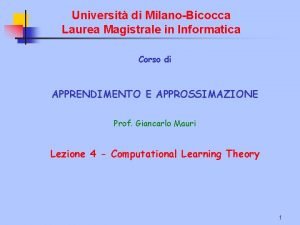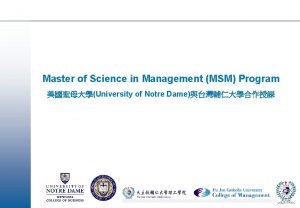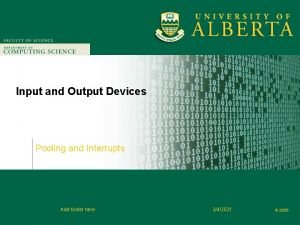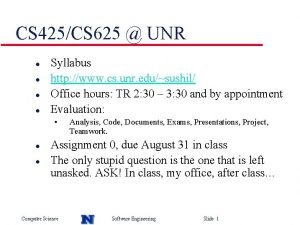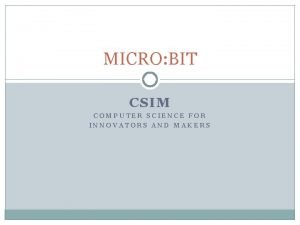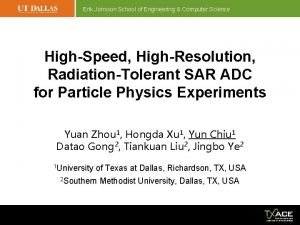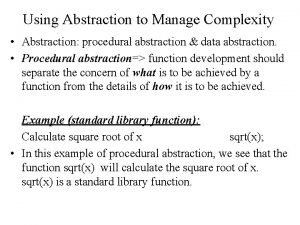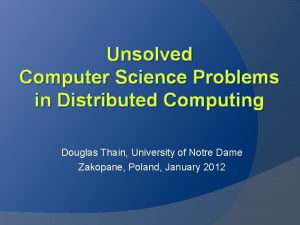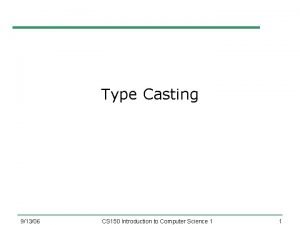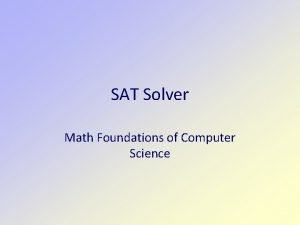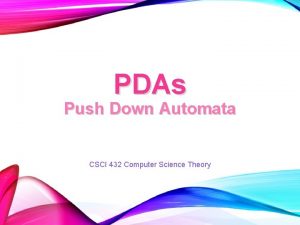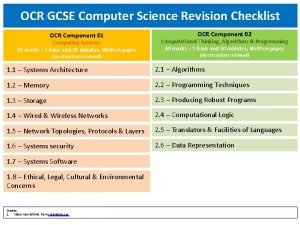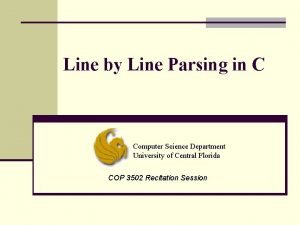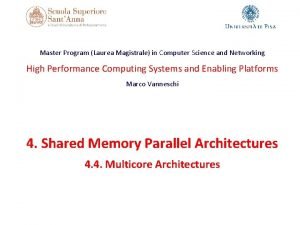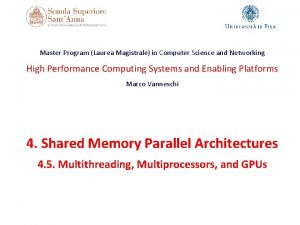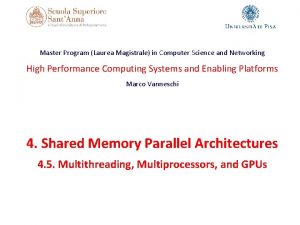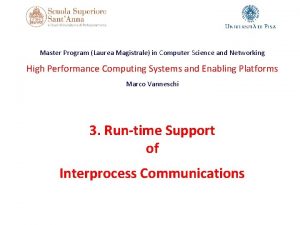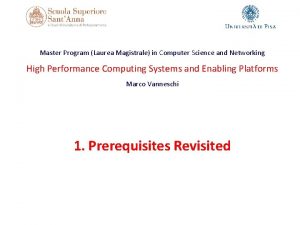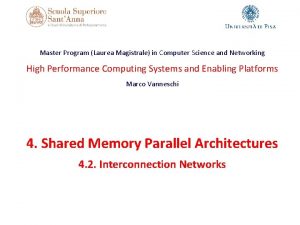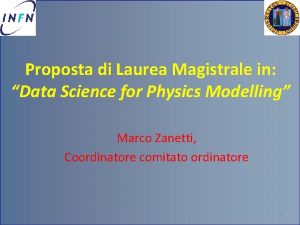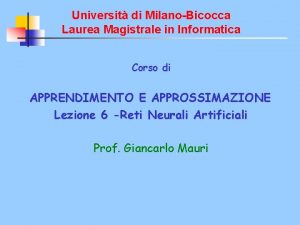Master Program Laurea Magistrale in Computer Science and







![Pipelining and loop unfolding M : : int A[m]; int s, s 0; { Pipelining and loop unfolding M : : int A[m]; int s, s 0; {](https://slidetodoc.com/presentation_image_h2/da9ea965f970bbece2c8735af0c94175/image-8.jpg)














![RG 1 consistency • Each General Register RG 1[i] has associated a non-negative integer RG 1 consistency • Each General Register RG 1[i] has associated a non-negative integer](https://slidetodoc.com/presentation_image_h2/da9ea965f970bbece2c8735af0c94175/image-23.jpg)







































![Solution of Exercize 1 Sequential algorithm, O(M 2): int A[M][M]; int B[M]; int C[M]; Solution of Exercize 1 Sequential algorithm, O(M 2): int A[M][M]; int B[M]; int C[M];](https://slidetodoc.com/presentation_image_h2/da9ea965f970bbece2c8735af0c94175/image-63.jpg)


























- Slides: 89

Master Program (Laurea Magistrale) in Computer Science and Networking High Performance Computing Systems and Enabling Platforms Marco Vanneschi 2. Instruction Level Parallelism 2. 1. Pipelined CPU 2. 2. More parallelism, data-flow model

Improving performance through parallelism Sequential Computer • The sequential programming assumption – User’s applications exploit the sequential paradigm: technology pull or technology push? • Sequential cooperation P – MMU – Cache – Main Memory – … – Request-response cooperation: low efficiency, limited performance – Caching: performance improvement through latency reduction (memory access time), even with sequential cooperation • Further, big improvement: increasing CPU bandwidth, through CPUinternal parallelism – Instruction Level Parallelism (ILP): several instructions executed in parallel – Parallelism is hidden to the programmer • The sequential programming assumption still holds – Parallelism is exploited at the firmware level (parallelization of the firmware interpreter of assembler machine) – Compiler optimizations of the sequential program, exploiting the firmware parallelism at best MCSN - M. Vanneschi: High Performance Computing Systems and Enabling Platforms 2

ILP: which parallelism paradigm? Parallelism paradigms / parallelism forms • Stream parallelism – – Pipeline Farm Data-flow … All forms are feasible: Pipelined implementation of the firmware interpreter Replication of some parts of the firmware interpreter Data-flow ordering of instructions • Data parallelism – Map – Stencil – … • Stream + data parallelism – Map / stencil operating on streams – … MCSN - Vectorized instructions Vectorized implementation of some parts of the firmware interpreter M. Vanneschi: High Performance Computing Systems and Enabling Platforms 3

Pipeline paradigm in general Module operating on stream M Stream of x Stream of y "x : y = F (x) = F 2 (F 1 (F 0 (x) ) ) Tseq = TF 0 + TF 1 + TF 2 F 0 F 1 F 2 M 0 M 1 M 2 T 0 = TF 0 + Tcom T 1 = TF 1 + Tcom Stream of y Parallelism degree: n = 3 T 2 = TF 2 + Tcom Service Time: Tpipe = max (T 0, T 1, …, Tn-1) parallelism degree n Tpipe-id = Tseq / n Efficiency: e = Tpipe-id/Tpipe = Tseq / (n max (T 0, T 1, …, Tn-1)) if TF 0 = TF 1 = … = TFn-1 = t : Tpipe = t + Tcom if Tcom = 0 : Tpipe = Tpipe-id = Tseq / n fully overlapped communications For balanced, fully overlapped pipeline structures: processing bandwidth: efficiency: e = 1 MCSN - balanced pipeline Bpipe = Bpipe-id = n Bseq M. Vanneschi: High Performance Computing Systems and Enabling Platforms 4

Pipeline latency Module operating on stream M Stream of x Stream of y "x : y = F (x) = F 2 (F 1 (F 0 (x) ) ) latency Lseq = TF 0 + TF 1 + TF 2 F 0 F 1 F 2 M 0 M 1 M 2 Stream of x Stream of y L 0 = TF 0 + Lcom Latency: L 1 = TF 1 + Lcom L 2 = TF 2 + Lcom ≥ Lseq Bandwidth improvement at the expense of increased latency wrt the sequential implementation. MCSN - M. Vanneschi: High Performance Computing Systems and Enabling Platforms 5

Pipeline completion time Steady state period m = stream length (= 2) n = parallelism degree (= 2) T (n) = service time with parallelism degree n Filling transient period Emptying transient period If m >> n : The fundamental relation between completion time and service time, valid for “long streams” (e. g. instruction sequence of a program …) MCSN - M. Vanneschi: High Performance Computing Systems and Enabling Platforms 6

Pipeline with internal state … Mi Mi-1 Si-1 Mi+1 Si … Si+1 • Computation with internal state: for each stream element, the output value depends also on an internal state variable, and the internal state is updated. • Partitioned internal state: if disjoint partitions of the state variable can be recognized and they are encapsulated into distinct stages and each stage operates on its own state partition only, then the presence of internal state has no impact on service time. • However, if state partitions are related each other, i. e. if there is a STATE CONSISTENCY PROBLEM, then some degradation of the service time exists. MCSN - M. Vanneschi: High Performance Computing Systems and Enabling Platforms 7
![Pipelining and loop unfolding M int Am int s s 0 Pipelining and loop unfolding M : : int A[m]; int s, s 0; {](https://slidetodoc.com/presentation_image_h2/da9ea965f970bbece2c8735af0c94175/image-8.jpg)
Pipelining and loop unfolding M : : int A[m]; int s, s 0; { < receive s 0 from input_stream >; s = s 0 ; for (i = 0; i < m; i++) s = F (s, A[i]); < send s onto output_stream > } k-unfolding M : : k times k-stage balanced pipeline with A partitioned (k partitions) int A[m]; int s; { < receive s 0 from input_stream >; s = s 0; for (i = 0; i < m/k; i++) s = F (s, A[i]); for (i = m/k; i < 2 m/k; i++) s = F (s, A[i]); … for (i = (k-1)m/k ; i < m; i++) s = F (s, A[i]); < send s onto output_stream > } Formally, this transformation implements a form of stream data-parallelism with stencil: • simple stencil (linear chain), • optimal service time, • but increased latency compared to nonpipelined data-parallel structures. MCSN - M. Vanneschi: High Performance Computing Systems and Enabling Platforms 8

From sequential CPU … M Memory Interface (MINF) MMU C I/O . . . MCSN - Interrupt arbiter P M. Vanneschi: High Performance Computing Systems and Enabling Platforms CPU chip 9

… to pipelined CPU Parallelization of the firmware interpreter while (true) do instruction fetch (IC); instruction decoding; Generate stream • instruction stream Recognize pipeline stages • corresponding to interpreter phases (possible) operand fetch; Load balance of stages execution; Pipeline with internal state (possible) result writing; IC update; • problems of state consistency < interrupt handling: firmware phase > • “impure” pipeline MCSN - • impact on performance M. Vanneschi: High Performance Computing Systems and Enabling Platforms 10

Basic principle of Pipelined CPU: simplified view M becomes Instruction Unit (IU) Instruction Memory (IM) P Data Memory (DM) Execution Unit (EU) t IM Instruction stream generation: consecutive instruction addresses 3 3 IU Instruction decode, data addresses generation 3 Data accesses DM EU 1 2 3 Execution phase In principle, a continuous stream of instructions feeds the pipelined execution of the firmware interpreter; each pipeline stage corresponds to an interpreter phase. MCSN - M. Vanneschi: High Performance Computing Systems and Enabling Platforms 11

Pipelined CPU: an example M Bus I/O MINF MMUI IC 1 MMUD TAB-CI TAB-CD IM DM CI IC CD IU EU RG 1 Int. Arb. RG CPU chip (primary cache only is shown for simplicity) MCSN - . . . M. Vanneschi: High Performance Computing Systems and Enabling Platforms • IM: Instruction Memory • MMUI: Instruction Memory MMU • CI: Instruction Cache • TAB-CI: Instruction Cache Relocation • • DM: Data. Memory MMUD: Data Memory MMU CD: Data Cache TAB-CD: Data Cache Relocation • IU: Instruction prepation Unit; possibly parallel • EU: instruction Execution Unit ; possibly parallel/pipelined • RG: General Registers, primary copy • RG 1: General Registers, secondary copy • IC: program counter, primary copy • IC 1: program counter, 12 secondary copy

Main tasks of the CPU units (simplified) • IM : generates the instruction stream at consecutive addresses (IC 1); if a new value IC 1 is received by IU, re-starts the stream generation starting from this value – IM service time = 1 t + Tcom = 2 t (Ttr = 0) • IU : receives instruction from IM; if valid then, according to instruction class: – if arithmetic instruction: sends instruction to EU – if LOAD: sends instruction to EU, computes operand address on updated registers, sends reading request to DM – if STORE: sends instruction to EU, computes operand address on updated registers, sends writing request to DM (address and data) – if IF: verifies branch condition on general registers; if true then updates IC with the target address and sends IC value to IM, otherwise increments IC – if GOTO: updates IC with the target address and sends IC value to IM • IU service time = 1 t + Tcom = 2 t (Ttr = 0) MCSN - M. Vanneschi: High Performance Computing Systems and Enabling Platforms 13

Main tasks of the CPU units (simplified) • DM : receives request from IU and executes it; if a reading operation then sends the read value to EU • DM service time = 1 t + Tcom = 2 t (Ttr = 0) • EU : receives request from IU and executes it: – if arithmetic instruction: executes the corresponding operation, stores the results into the destination register, and sends it to IU – if LOAD: wait for operand from DM, stores it into the destination register, and sends it to IU. • EU service time = 1 t + Tcom = 2 t (Ttr = 0); latency may be 1 t or greater MCSN - M. Vanneschi: High Performance Computing Systems and Enabling Platforms 14

AMD Opteron X 4 (Barcelona) MCSN - M. Vanneschi: High Performance Computing Systems and Enabling Platforms 15

Pipeline abstract architecture The CPU architecture “as seen” by the compiler IC 1 IM It captures the essential features for defining an effective cost model of the CPU DM First assumption: Pure Risc (e. g. D -RISC) IC IU RG 1 EU RG • all stages have the same service time: well balanced: t = Tid • Ttr= 0: if t ≥ 2 t Tcom = 0 The compiler can easily simulate the program execution on this abstract architecture, or an analytical cost model can be derived. MCSN - for very fine grain operations, all communications are fully overlapped to internal calculations M. Vanneschi: High Performance Computing Systems and Enabling Platforms 16

Example 1 1. 2. 3. LOAD ADD … t IM IU R 1, R 0, R 4, R 5, R 6 Execution simulation: to determine service time T and efficiency e 2 t Instruction sequences of this kind are able to fully exploit the pipelined CPU. 3 2 3 asynchronous com. DM EU 1 2 In fact, in this case CPU behaves as a “pure” pipeline. No performance degradation. “Skipping” DM stage has no impact on service time, in this example. MCSN - M. Vanneschi: High Performance Computing Systems and Enabling Platforms 17

Peak performance • For t ≥ 2 t Tcom = 0 • Assume: t = 2 t for all processing units – – including EU: arithmetic operations have service time 2 t floating point arithmetic: pipeline implementation (e. g. , 4 or 8 stages …) for integer arithmetic: latency 2 t (e. g. , hardware multiply/divide) however, this latency does not hold for floating point arithmetic, e. g. 4 or 8 times greater • CPU Service time: T = Tid = t • Performance: P id= 1/Tid = 1/2 t = fclock/2 – • e. g. fclock = 4 GH 2, P id= 2 GIPS Meaning: an instruction is fetched every 2 t – – • instructions/sec i. e. , a new instruction is processed every 2 t from the evaluation viewpoint, the burden between assembler and firmware is vanishing! – marginal advantage of firmware implementation: microinstruction parallelism Further improvements (e. g. , superscalar) will lead to P id= w/t = w fclock , w ≥ 1 MCSN - M. Vanneschi: High Performance Computing Systems and Enabling Platforms 18

Performance degradations • For some programs, the CPU is not able to operate as a “pure” pipeline • Consistency problems on replicated copies: – RG in EU, RG 1 in IU associated synchronization mechanism – IC in IU, IC 1 in IM associated synchronization mechanism • In order to guarantee consistency through synchronization, some “bubbles” are introduced in the pipeline flow – increased service time • Consistency of RG, RG 1: LOGICAL DEPENDENCIES ON GENERAL REGISTERS (“data hazards”) • Consistency of IC, IC 1: BRANCH DEGRADATIONS (“control hazards or branch hazards”) MCSN - M. Vanneschi: High Performance Computing Systems and Enabling Platforms 19

Example 2: branch degradation 1. 2. 3. 4. LOAD ADD GOTO … R 1, R 0, R 4, R 5, R 6 L t IM IU DM EU 1 4 t 2 3 4 L 1 2 3 4 1 2 L 1 Abstract architecture: exactly one time interval t is wasted (approximate evaluation of the concrete architecture) MCSN - M. Vanneschi: High Performance Computing Systems and Enabling Platforms 20

Example 3: logical dependency 1. 2. 3. LOAD ADD STORE R 1, R 0, R 4, R 5, R 6 R 2, R 0, R 6 t IM IU DM EU 1 Logical dependency, induced by instruction 2 on instruction 3; distance k =1 5 t 2 1 Instruction 3: when processed by IU, it needs the updated value of RG[6] contents. Thus, IU must wait for the completion of execution of instruction 2 in EU. 3 2 In this case, two time intervals t are wasted (approximate view of the abstract architecture). 3 1 2 The impact of execution latency is significant (in this case, DM is involved because of the LOAD instruction). If an arithmetic instruction were in place of LOAD: the bubble skinks to one time interval t. MCSN - M. Vanneschi: High Performance Computing Systems and Enabling Platforms 21

Pipelined D-RISC CPU: implementation issues M Bus I/O Assume a D-RISC machine MINF MMUI IC 1 MMUD TAB-CI TAB-CD IM DM CI IC MCSN - CD IU EU RG 1 Int. Arb. . Verify the feasibility of the abstract architecture characteristic: all stages have the same service time = 2 t. RG CPU chip M. Vanneschi: High Performance Computing Systems and Enabling Platforms RG-RG 1 consistency: integer semaphore mechanism associated to RG 1. IC-IC 1 consistency: unique identifier associated to instructions from IM, in order to accept or to discard them in IU. 22
![RG 1 consistency Each General Register RG 1i has associated a nonnegative integer RG 1 consistency • Each General Register RG 1[i] has associated a non-negative integer](https://slidetodoc.com/presentation_image_h2/da9ea965f970bbece2c8735af0c94175/image-23.jpg)
RG 1 consistency • Each General Register RG 1[i] has associated a non-negative integer semaphore S[i] • For each arithmetic/LOAD instruction having RG[i] as destination, IU increments S[i] • Each time RG 1[i] is updated with a value sent from EU, IU decrements S[i] • For each instruction that needs RG[i] to be read by IU (address components for LOAD, address components and source value for STORE, condition applied to registers for IF, address in register for GOTO), IU waits until condition (S[i] = 0) holds MCSN - M. Vanneschi: High Performance Computing Systems and Enabling Platforms 23

IC 1 consistency • Each time IU executes a branch or jump, IC is updated with the new target address, and this value is sent to IM • As soon as it is received by IU, IM writes the new value into IC 1 • Every instruction sent to IU is accompanied by the IC 1 value • For each received instruction, IU compares the value of IC with the received value of IC 1: the instruction is valid if they are equal, otherwise the instruction is discarded. • Notice that IC (IC 1) acts as a unique identifier. Alternatively, a shorter identifier can be generated by IU and sent to IM. MCSN - M. Vanneschi: High Performance Computing Systems and Enabling Platforms 24

Detailed tasks of the CPU units • IM – MMUI : translates IC 1 into physical address IA of instruction, sends (IA, IC 1) to TAB-CI, and increments IC 1 • when a new message is received from IU, MMUI updates IC 1 – TAB-CI : translates IA into cache address CIA of instruction, or generates a cache fault condition MISS), and sends (CIA, IC 1, MISS) to CI – CI : if MISS is false, reads instruction INSTR at address CIA and sends (INSTR, IC 1) to IU; otherwise performs the block transfer, then reads instruction INSTR at address CIA and sends (INSTR, IC 1) to IU MCSN - M. Vanneschi: High Performance Computing Systems and Enabling Platforms 25

Detailed tasks of the CPU units • IU – when receiving (regaddr, val) from EU writes val into RG[regaddr] and decrements S[regaddr] or – when receiving (INSTR, IC 1), if IC = IC 1 the instruction is valid and IU goes on, otherwise discards the instruction – if type = arithmetic (COP, Ra, Rb, Rc), sends instruction to EU, increments S[c] – if type = LOAD (COP, Ra, Rb, Rc), waits for updated values of RG[a] and RG[b], sends request (read, RG[a] + RG[b]) to DM, increments S[c] – if type = STORE (COP, Ra, Rb, Rc), waits for updated values of RG[a], RG[b] and RG[c], sends request (read, RG[a] + RG[b], RG[c]) to DM – if type = IF (COP, Ra, Rb, OFFSET), waits for updated values of RG[a] and RG[b], if branch condition is true then IC = IC + OFFSET and sends the new IC to IM, otherwise IC = IC +1 – if type = GOTO (COP, OFFSET), IC = IC + OFFSET and sends the new IC to IM – if type = GOTO (COP, Ra), waits for updated value of RG[a], IC = RG[a] and sends the new IC to IM MCSN - M. Vanneschi: High Performance Computing Systems and Enabling Platforms 26

Detailed tasks of the CPU units • DM – MMUD : receives (op, log_addr, data) from IU, translates log_addr into phys_addr, sends (op, phys_addr, data) to TAB_CD – TAB-CD : translates phys_addr into cache address CDA, or generates a cache fault condition MISS), and sends (op, CDA, data, MISS) to CD – CD : if MISS is false, then according to op: • reads VAL at address CDA and sends VAL to EU; • otherwise writes data at address CDA; if MISS is true: performs block transfer; completes the requested operation as before • EU – receives instruction (COP, Ra, Rb, Rc) from IU – if type = arithmetic (COP, Ra, Rb, Rc), executes RG[c] = COP(RG[a], RG[b]), sends the new RG[c] to IU – if type = LOAD (COP, Ra, Rb, Rc), waits VAL from DM, RG[c] = VAL, sends VAL to IU MCSN - M. Vanneschi: High Performance Computing Systems and Enabling Platforms 27

Cost model • To be evaluated on the abstract architecture: good approximation • Branch degradation: l = branch probability T = l 2 t + (1 – l) t = (1 + l) t • Logical dependencies degradation: T = (1 + l) t + D D = average delay time in IU processing • Efficiency: MCSN - M. Vanneschi: High Performance Computing Systems and Enabling Platforms 28

Example 1. 2. 3. 4. … LOAD ADD GOTO R 1, R 0, R 4, R 5, R 6 L D=0 l = 1/3 MCSN - M. Vanneschi: High Performance Computing Systems and Enabling Platforms 29

Logical dependencies degradation • Formally, D is the response time RQ in a client-server system • Server: DM-EU subsystem • A logical queue of instructions is formed at the input of DMEU server • Clients: logical instances of the IM-IU subsystem, corresponding to queued instructions sent to DM-EU • Let d = average probability of logical dependencies D = d RQ • How to evaluate RQ? MCSN - M. Vanneschi: High Performance Computing Systems and Enabling Platforms 30

Client – server systems in general (at any level) Assume a request-response behaviour: C 1 a client sends a request to the server, . . . Q Cn S The service time of each client is delayed by the RESPONSE TIME of the server. Modeling and evaluation as a Queueing System. Ci: : initialize x … while (true) do { < send x to S >; < receive y from S >; x = G (y, …) } MCSN - then waits for the response from the server. S: : while (true) do { < receive x from C C 1, …, Cn >; y = F (x, …) ; < send y to C > } M. Vanneschi: High Performance Computing Systems and Enabling Platforms 31

Client-server queueing modeling Tcl: average service time of generic client TG: ideal average service time of generic client RQ: average response time of server r: server queue utilization factor TS: average service time of server LS: average latency time of server s. S: other service time distribution parameters (e. g. , variance of the service time of the server) TA: average interarrival time to server n: number of clients (assumed identical) System of equations to be solved through analytical or numerical methods. One and only one real solution exists satisfying the constraint: r < 1. This methodology will be applied several times during the course. MCSN - M. Vanneschi: High Performance Computing Systems and Enabling Platforms 32

Typical results: server utilization degree (= r) MCSN - M. Vanneschi: High Performance Computing Systems and Enabling Platforms 33

Typical results: client efficiency (= TG/Tcl) MCSN - M. Vanneschi: High Performance Computing Systems and Enabling Platforms 34

Parallel server: the impact of service time and of latency • A more significant way to express the Response Time, especially for a parallel server: RQ = WQ (r, …) + LS • WQ: average Waiting Time in queue (queue of clients requests): WQ depends on the utilization factor r, thus on the service time only (not on latency) • • LS is the latency of server Separation of the impact of service time and of latency All the parallelism paradigms aim to reduce the service time Some parallelism paradigms are able to reduce the latency too – Data-parallel, data-flow, … while other paradigms increase the latency – Pipeline, farm, … • Overall effect: in which cases does the service time (latency) impact dominates on the latency (service time) impact ? • For each server-parallelization problem, the relative impact of service time and latency must be carefully studied in order to find a satisfactory trade-off. MCSN - M. Vanneschi: High Performance Computing Systems and Enabling Platforms 35

Pipeline CPU: approximate evaluation of D • • For a D-RISC machine Evaluation on the abstract architecture Let: – k = distance of a logical dependency – dk = probability of a logical dependency with distance k – NQ = average number of instructions waiting in DM-EU subsystem It can be shown that: where summation is extended to non-negative terms only. NQ = 2 if the instruction inducing the logical dependency is the last instruction of a sequence containing all EU-executable instructions and at least one LOAD, otherwise NQ = 1. MCSN - M. Vanneschi: High Performance Computing Systems and Enabling Platforms 36

D formula for D-RISC: proof • D = d 1 D 1 + d 2 D 2 + … • dk = probability of logical dependency with distance k • Dk = RQk = WQk + LS • WQk = average number of queued instructions that (with probability dk) precede the instruction inducing the logical dependency • LS = Latency of EU in D-RISC; with hardware-implemented arithmetic operations on integers LS = t • Dk = WQk + t • Problem: find a general expression for WQk • The number of distinct situations that can occur in a D-RISC abstract architecture is very limited • Thus, the proof can be done by enumeration. • Let us individuate the distinct situations. MCSN - extended to non-negative terms only M. Vanneschi: High Performance Computing Systems and Enabling Platforms 37

D formula for D-RISC: proof Case A: 1. ADD …, …, R 1 2. STORE …, …, R 1 distance k = 1 probability d 1 WQ = 0: when 2 is in IU, 1 is in EU (current service) D = d 1 (WQ + Ls) = d 1 t Case B: 1. ADD …, …, R 1 2. SUB …, …, R 2 3. STORE …, …, R 1 distance k = 2 probability d 2 WQ = 1 t: when 3 is in IU, 1 has been already executed D = d 2 (WQ + Ls) = 0 Case C: 1. LOAD …, …, … 2. ADD …, …, R 1 3. STORE …, …, R 1 distance k = 1 probability d 1 WQ = 1 t: when 3 is in IU, 1 is in EU (current service), 2 is waiting in queue D = d 1 (WQ + Ls) = 2 d 1 t Case D: 1. LOAD …, …, … 2. ADD …, …, R 1 3. SUB …, …, R 2 4. STORE …, …, R 1 distance k = 2 probability d 2 WQ = 0: when 4 is in IU, 2 is in EU (current service) D = d 2 (WQ + Ls) = d 2 t In all other cases D = 0, in particular for k > 2. MCSN - M. Vanneschi: High Performance Computing Systems and Enabling Platforms 38

D formula for D-RISC: proof • WQk = number of queued instructions preceding the instruction that induces the logical dependency • Maximum value of WQk = 1 t: – the instruction currently executed in EU has been delayed by a previous LOAD, and the instruction inducing the logical dependency is still in queue • Otherwise: WQk = 0 or WQk = - 1 t – WQk = 0: the instruction currently executed in EU induces the logical dependency, – WQk = 0: the instruction currently executed in EU has been delayed by a previous LOAD, and it is the instruction inducing the logical dependency – WQk = -1 t: the instruction inducing the logical dependency has been already executed • To be proven that: WQk = (NQk – k)t – NQk = 2 if the instruction inducing the logical dependency is the last instruction of a sequence containing all EU-executable instructions and at least one LOAD, – otherwise NQk = 1. MCSN - M. Vanneschi: High Performance Computing Systems and Enabling Platforms 39

D formula for D-RISC: proof Case A: 1. ADD …, …, R 1 2. STORE …, …, R 1 distance k = 1 probability d 1 WQ = 0: when 2 is in IU, 1 is in EU (current service) Case B: 1. ADD …, …, R 1 2. SUB …, …, R 2 3. STORE …, …, R 1 distance k = 2 probability d 2 WQ = 1 t: when 3 is in IU, 1 has been already executed Case C: 1. LOAD …, …, … 2. ADD …, …, R 1 3. STORE …, …, R 1 distance k = 1 probability d 1 WQ = 1 t: when 3 is in IU, 1 is in EU (current service), 2 is waiting in queue Case D: 1. LOAD …, …, … 2. ADD …, …, R 1 3. SUB …, …, R 2 4. STORE …, …, R 1 distance k = 2 probability d 2 WQ = 0: when 4 is in IU, 2 is in EU (current service) D = d 1 (WQ + Ls) = d 1 t NQ = 1, WQ = (NQ–k)t = 0 D = d 2 (WQ + Ls) = 0 NQ = 1, WQ = (NQ–k)t = 1 t D = d 1 (WQ + Ls) = 2 d 1 t NQ = 2, WQ = (NQ–k)t = 1 t D = d 2 (WQ + Ls) = d 2 t NQ = 2, WQ = (NQ–k)t = 0 In all other cases D = 0 : k > 2, or k = 2 and NQ = 1 MCSN - M. Vanneschi: High Performance Computing Systems and Enabling Platforms 40

Example 1. LOAD R 1, R 0, R 4 2. ADD R 4, R 5, R 6 3. STORE R 2, R 0, R 6 l=0 One logical dependency induced by instruction 2 on instruction 3: distance k = 1, probability d 1 = 1/3, NQ = 2 MCSN - M. Vanneschi: High Performance Computing Systems and Enabling Platforms 41

Example 1. 2. 3. 4. 5. 6. 7. L: LOAD ADD STORE INCR IF < END R 1, R 0, R 4 R 2, R 0, R 5 R 4, R 5, R 4 R 3, R 0, R 4 R 0, R 6, L Two logical dependencies with the same distance (= 1): the one with NQ = 2, the other with NQ = 1 MCSN - M. Vanneschi: High Performance Computing Systems and Enabling Platforms 42

Note: intermixed/nested logical dependencies 5. 6. 7. Logical dependency induced by 5 on 7 has no effect. MCSN - 4. 5. 6. 7. Logical dependency induced by 4 on 7 has no effect. M. Vanneschi: High Performance Computing Systems and Enabling Platforms 43

Cache faults • All the performance evaluations must be corrected taking into account also the effects of cache faults (Instruction Cache, Data Cache) on completion time. • The added penalty for block transfer (data) – Worst-case: exactly the same penalty studied for sequential CPUs (See Cache Prerequisites), – Best-case: no penalty - fully overlapped to instruction pipelining MCSN - M. Vanneschi: High Performance Computing Systems and Enabling Platforms 44

Compiler optimizations • Minimize the impact of branch degradations: • DELAYED BRANCH = try to fill the branch bubbles with useful instructions Ø Annotated instructions • Minimize the impact of logical dependencies degradations: • CODE MOTION = try to increase the distance of logical dependencies • Preserve program semantics, i. e. transformations that satisfy the Bernstein conditions for correct parallelization. MCSN - M. Vanneschi: High Performance Computing Systems and Enabling Platforms 45

Bernstein conditions Given the sequential computation: R 1 = f 1(D 1) ; R 2 = f 2(D 2) it can be transformed into the equivalent parallel computation: R 1 = f 1(D 1) R 2 = f 2(D 2) if all the following conditions hold: R 1 D 2 = (true dependency) R 1 R 2 = (antidependency) D 1 R 2 = (output dependency) Notice: for the parallelism inside a microinstruction (see Firmware Prerequisites), only the first and seconditions are sufficient (synchronous model of computation). E. g. A + B C ; D + E A is equivalent to: A + B C , D + E A MCSN - M. Vanneschi: High Performance Computing Systems and Enabling Platforms 46

Delayed branch: example 1. 2. 3. 4. 5. 6. 7. 8. MCSN - L: LOAD ADD STORE INCR IF < END LOAD ADD STORE INCR IF < LOAD END R 1, R 0, R 4 R 2, R 0, R 5 R 4, R 5, R 4 R 3, R 0, R 4 R 0, R 6, L l=0 R 1, R 0, R 4 R 2, R 0, R 5 R 4, R 5, R 4 R 3, R 0, R 4 R 0, R 6, L, delayed_branch R 1, R 0, R 4 (previous version: e = 3/5) M. Vanneschi: High Performance Computing Systems and Enabling Platforms 47

Increase logical dependency distance: example 1. 2. 3. 4. 5. 6. 7. 8. L: LOAD ADD STORE INCR IF < LOAD END For this transformation, the compiler initializes register R 3 at the value Base_C - 1 where Base_C is the base address of the result array. R 1, R 0, R 4 R 2, R 0, R 5 R 4, R 5, R 4 R 3, R 0, R 4 R 0, R 6, L, delayed_branch R 1, R 0, R 4 d 1= 1/6 1. 2. 3. 4. 5. 6. 7. 8. L: LOAD ADD INCR STORE IF < LOAD END R 1, R 0, R 4 R 2, R 0, R 5 R 4, R 5, R 4 R 0 R 3, R 0, R 4 R 0, R 6, L, delayed_branch R 1, R 0, R 4 (previous version: e = 2/3) Tc = 6 N T = 8 N t MCSN - M. Vanneschi: High Performance Computing Systems and Enabling Platforms 48

Exploit both optimizations jointly 1. 2. 3. 4. 5. 6. 8. L: 1. 2. 3. 4. 6. 6. 7. L: LOAD ADD STORE INCR IF < END LOAD INCR ADD IF < STORE END R 1, R 0, R 4 R 2, R 0, R 5 R 4, R 5, R 4 R 3, R 0, R 4 R 0, R 6, L, delayed_branch R 1, R 0, R 4 R 2, R 0, R 5 R 0 R 4, R 5, R 4 R 0, R 6, L, delayed_branch R 3, R 0, R 4 (previous version: e = 3/4) Tc = 6 N T = 7 N t MCSN - M. Vanneschi: High Performance Computing Systems and Enabling Platforms 49

Exercizes 1. Compile, with optimizations, and evaluate the completion time of a program that computes the matrix-vector product (operands: int A[M][M], int B[M]; result: int C[M], where M = 104) on a D-RISC Pipeline machine. The evaluation must include the cache fault effects, assuming the Data Cache of 64 K words capacity, 8 words blocks, operating on-demand. 2. Consider the curves at pages 33, 34. Explain their shapes in a qualitative way (e. g. why e tends asymtotically to an upper bound value as TG tends to infinity, …). MCSN - M. Vanneschi: High Performance Computing Systems and Enabling Platforms 50

Exercize 3. Systems S 1 and S 2 have a Pipelined CPU architecture. S 1 is a D-RISC machine. The assembler level of S 2 is D-RISC enriched with the following instruction: REDUCE_SUM RA, RN, Rx with RG[RA] = base address of an integer array A[N], and RG[RN] = N. The semantics of this instruction is RG[Rx] = reduce (A[N], +) Remember that reduce (H[N], ) where is any associative operator, is a second-order function whose result is equal to the scalar value H[0] H[1] … H[N-1] a) Explain how a reduce (A[N], +) is compiled on S 1 and how it is implemented on S 2, and evaluate the difference d in the completion times of reduce on S 1 and on S 2. b) A certain program includes reduce (A[N], +) executed one and only one time. Explain why the difference of the completion times of this program on S 1 and on S 2 could be different compared to d as evaluated in point a). MCSN - M. Vanneschi: High Performance Computing Systems and Enabling Platforms 51

Execution Unit and “long” instructions • The EU implementation of “long” arithmetic operations, e. g. – – integer multiplication, division floating point addition floating point multiplication, division other floating point operations (square root, sin, cosin, …) has to respect some basic guidelines: A. to mantain the EU service time equal to the CPU ideal service time Tid, B. to minimize the EU latency in order to minimize the logical dependencies degradation. • To deal with issues A, B we can apply: A. Parallel paradigms at the firmware level B. Data-parallel paradigms and special hardware implementations of arithmetic operations. MCSN - M. Vanneschi: High Performance Computing Systems and Enabling Platforms 52

Integer multiplication, division • A simple firmware implementation is a loop algorithm (similar to the familiar operation “by hand”), exploting additions/subtractions and shifts – Latency = O(word lenght) t 50 t (32 bit integers) • Hardware implementations in 1 -2 t exist, though expensive in terms of silicon area if applied to the entire word • Intermediate solution: firmware loop algorithm, in which few iterations are applied to parts of the word (e. g. byte), each iteration implemented in hardware. • Intermediate solutions exploiting parallel paradigms: – farm of firmware multiply-&-divide units: reduced service time, but not latency – loop-unfolding pipeline, with stages corresponding to parts (byte) implemented in hardware: reduced service time, latency as in the sequential version (intermediate). MCSN - M. Vanneschi: High Performance Computing Systems and Enabling Platforms 53

Multiplication through loop-unfolding pipeline Multiply a, b, result c Let byte (v, j) denote the j-th byte of integer word v Sequential multiplication algorithm (32 bit) exploiting the hardware implementation applied to bytes: init c; for (i = 0; i < 4; i++) c = combine ( c, hardware_multiplication ( byte (a, i), byte (b, i) ) ) Loop-unfolding pipeline (“systolic”) implementation: c byte (a, 0) byte (b, 0) byte (a, 1) byte (b, 1) byte (a, 2) byte (b, 2) byte (a, 3) byte (b, 3) hw_mul & combine c service time = 2 t, latency = 8 t MCSN - M. Vanneschi: High Performance Computing Systems and Enabling Platforms 54

Exercize 4. The cost model formula for D (given previously) is valid for a D-RISC-like CPU in which the integer multiplication/division operations are implemented entirely in hardware (1 - 2 clock cycles). Modify this formula for a Pipelined CPU architecture in which the integer multiplication/division operations are implemened as a 4 -stage pipeline. MCSN - M. Vanneschi: High Performance Computing Systems and Enabling Platforms 55

Pipelined floating point unit Example: FP addition FP number = (m, e), where: m = mantissa, e = exponent N 1 = (m 1, e 1) N 2 = (m 2, e 2) D = e 2 – e 1 m 1 = m 1 2 -D, m 2 = m 2 or m 1 = m 1, m 2 = m 2 2 -D m = m 1 + m 2 e = max (e 1, e 2) normalization MCSN - M. Vanneschi: High Performance Computing Systems and Enabling Platforms 56

Parallel EU schemes • Farm, where each worker is general-purpose, implementing addition/subtraction & multiply/divide on integer or floating point numbers. • Functional partitioning, where each worker implements a specific operation on integer or floating point numbers: INT Add / Sub dispatcher FP Pipelined Add / Sub collector INT Pipelined Mul / Div Floating Point Registers MCSN - FP Pipelined Mul / Div M. Vanneschi: High Performance Computing Systems and Enabling Platforms 57

Parallel EU: additional logical dependencies • More arithmetic instructions can be executed simultaneoulsy in a parallel EU. • This introduces additional logical dependencies “EU-EU” (till now: “IU-EU” only). For example, in the sequence: MUL Ra, Rb, Rc ADD Rd, Re, Rf the second instruction starts in EU as soon the first enters the pipelined multiplier, while in the sequence: MUL Ra, Rb, Rc ADD Rc, Re, Rf the second instruction is blocked in EU until the first is completed. The dispatcher units (see previous slide) is in charge of implementing the synchronization mechanism, according to a semaphoric technique similar to the one for synchronizing IU and EU. • Because of EU latency and EU-EU dependencies, it is more convenient to increase the asynchrony degree of the IU-EU channel, i. e. a Queueing Unit is inserted. In practice, this increases the number of pipeline stages of the machine. MCSN - M. Vanneschi: High Performance Computing Systems and Enabling Platforms 58

Data parallelism for arithmetic operations • Data parallelism is meaningful on large data structures, i. e. arrays, only • Vectorized assembler instructions operate on arrays, e. g. SUM_VECT base_address A, base_address B, base_address C, size N • Data parallel implementation: map at the firmware level – scatter arrays A, B – map execution – gather to obtain array C • Also: reduce, parallel prefix operations • Also: operations requiring stencil-based data parallel implementation, e. g. matrix-vector or matrix-matrix product, convolution, filters, Fast Fourier Transform. MCSN - M. Vanneschi: High Performance Computing Systems and Enabling Platforms 59

Pure Risc enriched by floating point pipelined and vectorized co-processors • Mathematical co-processors, connected as I/O units – instead of assembler instructions • FP / vector operations called as libraries containing I/O transfer operations (LOAD, STORE - Memory Mapped I/O - DMA) Main Memory DMA Bus. . . Memory Management Unit Cache Memory I/O Bus I/O 1 . . . I/Ok . Interrupt Arbiter Processor CPU MCSN - . co-processors . M. Vanneschi: High Performance Computing Systems and Enabling Platforms 60

Solutions of Exercizes • Exercize 1 • Exercize 3 • Exercize 4 MCSN - M. Vanneschi: High Performance Computing Systems and Enabling Platforms 61

Exercize 1 Compile, with optimizations, and evaluate the completion time of a program that computes the matrix-vector product (operands: int A[M][M], int B[M]; result: int C[M], where M = 104) on a D-RISC Pipeline machine. The evaluation must include the cache fault effects, assuming the Data Cache of 64 K words capacity, 8 words blocks, operating on-demand. MCSN - M. Vanneschi: High Performance Computing Systems and Enabling Platforms 62
![Solution of Exercize 1 Sequential algorithm OM 2 int AMM int BM int CM Solution of Exercize 1 Sequential algorithm, O(M 2): int A[M][M]; int B[M]; int C[M];](https://slidetodoc.com/presentation_image_h2/da9ea965f970bbece2c8735af0c94175/image-63.jpg)
Solution of Exercize 1 Sequential algorithm, O(M 2): int A[M][M]; int B[M]; int C[M]; for (i = 0; i < M; i++) C[i] = 0; for (j = 0; j < M; j++) C[i] = C[i] + A[i][j] B[j] Process virtual memory: – matrix A stored by row, M 2 consecutive words; – compilation rule for 2 -dimension matrices used in loops: for each iteration, base address = base address + M MCSN - M. Vanneschi: High Performance Computing Systems and Enabling Platforms 63

Solution of Exercize 1 Basic compilation (without optimizations): initialize RA, RB, RC, RM, Ri (=0); allocate Rj, Ra, Rb, Rc LOOP_i: CLEAR Rc CLEAR Rj LOOP_j: LOAD RA, Rj, Ra LOAD RB, Rj, Rb MUL Ra, Rb, Ra ADD Rc, Ra, Rc INCR Rj IF < Rj, RM, LOOP_j STORE RC, Ri, Rc ADD RA, RM, RA INCR Ri IF < Ri, RM, LOOP_i END MCSN - Completion time: Tc M 2 completion time of innermost loop Tc 6 M 2 T where T = service time per instruction Performance degradations in the outermost loop are not relevant (however, the compiler applies optimizations to this part too). M. Vanneschi: High Performance Computing Systems and Enabling Platforms 64

Solution of Exercize 1 Analysis of innermost loop (initially: perfect cache): LOOP_j: LOAD RA, Rj, Ra LOAD RB, Rj, Rb MUL Ra, Rb, Ra ADD Rc, Ra, Rc INCR Rj IF < Rj, RM, LOOP_j l = 1/6; k = 1, dk = 1/6, NQk = 2 T = (1 + l) t + dk t (NQk + 1 – k) = 9 t/6 e = 6/9 Tc 6 M 2 T = 9 M 2 t = 18 M 2 t MCSN - M. Vanneschi: High Performance Computing Systems and Enabling Platforms 65

Solution of Exercize 1 Optimization and evaluation of innermost loop (perfect cache): LOAD RA, Rj, Ra LOOP_j: LOAD RB, Rj, Rb INCR Rj MUL Ra, Rb, Ra ADD Rc, Ra, Rc IF < Rj, RM, LOOP_j, delayed_branch LOAD RA, Rj, Ra l = 0; k = 3 D = 0 T = t = Tid e=1 Tc 6 M 2 T = 6 M 2 t = 12 M 2 t Completion time difference = 6 M 2 t, ratio = 1. 5 MCSN - M. Vanneschi: High Performance Computing Systems and Enabling Platforms 66

Solution of Exercize 1 Impact of caching: Instruction faults: not relevant; reuse ; 2 fixed blocks in working set Matrix A, array C: locality only ; 1 block at the time for A and for C in working set Nfault-A = M 2/s, Nfault-C = M/s Array B: reuse (+ locality) ; all B blocks in working set; due to its size, B can be allocated entirely in cache Nfault-B = M/s LOAD RB, Rj, Rb, no_dellocation Assuming a secondary cache on chip: Tblock = s t Tfault = Nfault Tblock Nfault-A Tblock = M 2 t Worst–case assumption – pipeline is blocked when a block transfer occurs : Tc = Tc-perfect-cache + Tfault = 12 M 2 t + M 2 t = 13 M 2 t ecache = 12/13 In this case, if prefetching were applicable, Nfault-A = 0 and TC = Tc-perfect-cache , ecache = 1. LOAD RA, Rj, Ra, prefetching MCSN - M. Vanneschi: High Performance Computing Systems and Enabling Platforms 67

Solution of Exercize 1 Best-case assumption about block transfer corresponds a more realistic behaviuor : pipeline is working normally during a block transfer; only if a data dependency on the block value occurs, then a bubble in naturally introduced. In our case: During an A-block transfer, LOAD RA, Rj, Ra LOOP_j: LOAD RB, Rj, Rb INCR Rj • DM serves other requests in parallel (B is in cache), ADD Rc, Ra, Rc • LOAD RB, … can be correctly executed out-of-order IF < Rj, RM, LOOP_j, delayed_branch • INCR Rj can be executed, LOAD RA, Rj, Ra • MUL can start; EU waits for the element of A MUL Ra, Rb, Ra With secondary cache on chip, and s = 8, with these assumptions the block transfer is overlapped to pipeline behaviour: • when EU is ready the execute MUL, the A-block transfer has been completed in DM, • no (relevant) cache degradation, even without relaying on prefetching of A blocks. For out-of-order behaviour: see the slides after Branch Prediction. MCSN - M. Vanneschi: High Performance Computing Systems and Enabling Platforms 68

Exercize 3 Systems S 1 and S 2 have a Pipelined CPU architecture. S 1 is a D-RISC machine. The assembler level of S 2 is D-RISC enriched with the following instruction: REDUCE_SUM RA, RN, Rx with RG[RA] = base address of an integer array A[N], and RG[RN] = N. The semantics of this instruction is RG[Rx] = reduce (A[N], +) Remember that reduce (H[N], ) where is any associative operator, is a second-order function whose result is equal to the scalar value H[0] H[1] … H[N-1] a) Explain how a reduce (A[N], +) is compiled on S 1 and how it is implemented on S 2, and evaluate the difference d in the completion times of reduce on S 1 and on S 2. b) A certain program includes reduce (A[N], +) executed one and only one time. Explain why the difference of the completion times of this program on S 1 and on S 2 could be different compared to d as evaluated in point a). MCSN - M. Vanneschi: High Performance Computing Systems and Enabling Platforms 69

Solution of Exercize 3 a) System S 1. The sequential algorithm for x = reduce (A[N], +) having complexity O(N), can be compiled into the following optimized code for : LOAD RA, Ri, Ra LOOP: INCR Ri ADD Rx, Ra, Rx IF < Ri, RN, LOOP, delayed_branch LOAD RA, Ri, Ra Performance analysis, without considering possible cache degradations: l = 0; k = 2, dk = 1/4, NQk = 2 T = (1 + l) t + dk t (NQk + 1 – k) = 5 t/4 e = 4/5 Tc 1 4 N T = 5 N t = 10 N t MCSN - M. Vanneschi: High Performance Computing Systems and Enabling Platforms 70

Solution of Exercize 3 System S 2. The firmware interpreter of instruction REDUCE_SUM RA, RN, Rx on a pipeline CPU can be the following: IM microprogram: the same of S 1. IU microprogram for REDUCE: send instruction encoding to EU, produce a stream of N readrequests to DM with consecutive addresses beginning at RG[RA]. DM microprogram: the same of S 1. EU microprogram for REDUCE: initialize RG[Rx] at zero; loop for N times: wait data d from DM, RG[Rx] + d RG[Rx]; on completion, send RG[Rx] content to IU. Alternatively: IU send to DM just one request (multiple_read, N, base address RG[RA]), and DM produces a stream of consecutive-address data to EU (there is no advantage). MCSN - M. Vanneschi: High Performance Computing Systems and Enabling Platforms 71

Solution of Exercize 3 Considering the graphic simulation of this S 2 interpreter, we obtain the latency of REDUCE instruction on S 2, which is the completion time of a S 2 program consisting of REDUCE only (see the general formula for the completion time of the pipeline paradigm): Tc 2 N t = 2 N t Notice that there are no logical dependency nor branch degradations. The completion time ratio of the two implementations on S 1 and S 2 is equal to 5, and the difference d=8 Nt This example confirms the analysis of the comparison of assembler vs firmware implementation of the same functionality (see Exercize in prerequisites): the difference in latency is mainly due to the parallelism in microinstructions wrt sequential execution at the assembler level. In the example, this parallelism is relevant in the IU and EU behaviour. Moreover, the degradations are often reduced, because some computations occurs locally in some units (EU in our case) instead of requiring the interactions of distinct units with consistency synchronization problems (in our case, only the final result is communicated from EU to IU). MCSN - M. Vanneschi: High Performance Computing Systems and Enabling Platforms 72

Solution of Exercize 3 b) Consider a S 1 program containing the REDUCE routine and executing it just one time. The equivalent S 2 program contains the REDUCE instruction in place of the REDUCE routine. The differenze of completion times is less or equal than the d value of part a): • In S 1, the compiler has more degrees of freedom to introduce optimizations concerning the code sections before and after the REDUCE routine: – the REDUCE loop can be, at least partially, unfolded, – the compiler can try to introduce some code motions, in order to mix some instructions of the code sections before and after the REDUCE routine with the instructions of the REDUCE routine itself. This example shows the potentials for compiler optimizations of RISC systems compared to CISC: in some cases, such optimizations are able to compensate the RISC latency disadvantage, at least partially. MCSN - M. Vanneschi: High Performance Computing Systems and Enabling Platforms 73

Exercize 4 The cost model formula for D (given previously) is valid for a D-RISC-like CPU in which the integer multiplication/division operations are implemented entirely in hardware (1 - 2 clock cycles). Modify this formula for a Pipelined CPU architecture in which the integer multiplication/division operations are implemened as a 4 -stage pipeline. MCSN - M. Vanneschi: High Performance Computing Systems and Enabling Platforms 74

Solution of Exercize 4 Cost model for pipelined D-RISC CPU: where • NQ = 2 if the instruction inducing the logical dependency is the last instruction of a sequence containing all EU-executable instructions and at least one LOAD, otherwise NQ = 1 • summation is extended to non-negative terms only. In D-RISC, for k ≥ 3, D = 0. The meaning is that each Dk can be expressed as Dk = dk RQk = WQk + LS WQk = NQk – k = average number of queued instructions that (with probability dk) precede the instruction inducing the logical dependency LS = Latency of EU. With hardware-implemented arithmetic operations on integers: LS = t MCSN - M. Vanneschi: High Performance Computing Systems and Enabling Platforms 75

Solution of Exercize 4 A 4 -stage pipelined MUL/DIV operator has a latency: Ls-MUL/DIV = 4 t If p = prob(istruction is MUL or DIV), and all the other arithmetic operations are “short”, the average EU latency is: Ls = (1 + 3 p) t Then (the proof can be verified using the graphical simulation): This result can be generalized to any value of EU latency, for D-RISC like machines. Moreover, it is valid also for EU-EU dependencies. MCSN - M. Vanneschi: High Performance Computing Systems and Enabling Platforms 76

Branch prediction • For high-latency pipelined EU implementations, the effect on logical dependencies degradation is significant • When logical dependencies are applied to predicate evaluation in branch instructions, e. g. CONT: MUL Ra, Rb, Rc IF = Rc, Rd, CONT …. . false predicate path …. . true predicate path …. . the so-called Branch Prediction technique can be applied. MCSN - M. Vanneschi: High Performance Computing Systems and Enabling Platforms 77

Branch prediction • Try to continue along the path corresponding to false predicate (no branch) – Compile the program in such a way that the false predicate corresponds to the most probable event, if known or predictable • On- condition execution of this instruction stream – Save the RG state during this on-condition phase – Additional unit for RG copy; unique identifiers (IC) associated • When the values for predicate evaluation are updated, then verify the correctness of the on-condition execution, and, if the prediction was incorrect, apply a recovery action using the saved RG state. MCSN - M. Vanneschi: High Performance Computing Systems and Enabling Platforms 78

Branch prediction IU General Register Unit Reordering Buffer EU several versions of General Register values, with associated unique identifiers (e. g. 512 – 1024 registers) • Example of out-of-order execution. • From a conceptual viewpoint, the problem is similar to the implementation of an “ordering collector” in a farm structure. • Complexity, chip area and power consumption are increased by similar techniques. • Not necessarily it is a cost-effective technique. MCSN - M. Vanneschi: High Performance Computing Systems and Enabling Platforms 79

Out-of-order behaviour • • Branch prediction is a typical case of out-of-oder behaviour. LOAD RA, Rj, Ra LOOP_j: Other out-of-order situations can be recognized: for example see Solution of Exercize 1 about the best-case assumption for cache block transfer evaluation: LOAD RB, Rj, Rb INCR Rj MUL Ra, Rb, Ra ADD Rc, Ra, Rc IF < Rj, RM, LOOP_j, delayed_branch LOAD RA, Rj, Ra The base-case behaviour is implementable provided that LOAD RB, … can be executed during the cache fault handling caused by LOAD RA, …. That is, EU must be able to “skip” instruction LOAD RA, … and to execute LOAD RB, …, postponing the execution of LOAD RA, … until the source operand is sent by DM (LOAD RA, … instruction has been received by EU, but it has been saved in a EU internal buffer). This can be done • by a proper instruction ordering in the program code (e. g. the two LOADs can be exchanged), or • by compiler-provided annotations in instructions (if this facility exists in the definition of the assembler machine), or • by some rules in the firmware interpreter of EU: e. g. , the execution order of a sequence of LOAD instructions, received by EU, can be altered (no logical dependencies can exist between them if they have been sent to EU). MCSN - M. Vanneschi: High Performance Computing Systems and Enabling Platforms 80

Superscalar architectures: a first broad outline Basic case: 2 -issue superscalar • In our Pipelined CPU architecture, each element of the instruction stream generated by IM consists of 2 consecutive instructions – Instruction cache is 2 -way interleaved or each cell contains 2 words (“Long Word”) • IU prepares both instructions in parallel (during at most 2 clock cycles) and delivers them to DM/EU, or executes branches, provided that they are executable (valid instructions and no logical dependency) – It is also possibile that the first instruction induces a logical dependency on the second one, or it is a branch • • DM and EU can be realized with sufficient bandwidth to execute 2 instructions in 2 clock cycles Performance achievement: the communication latency (2 t) is fully masked: P id= 2/Tid = 1/t = fclock instructions/sec – e. g. fclock = 4 GH 2, P id= 4 GIPS though performance degradations are greater than in the basic Pipelined CPU (e is lower), unless more powerful optimizations are introduced – branch prediction, out-of-order MCSN - M. Vanneschi: High Performance Computing Systems and Enabling Platforms 81

Superscalar CPUs • In general, n-issue superscalar architectures can be realized v n = 2 – 4 – 8 – 16 instruction 0 instruction 1 instruction 2 Long Word instruction 3 IU Reordering Buffer, Dynamic Register Allocation Modular Data Cache Parallel – Pipelined EU Fixed MCSN - Fixed Float Registers M. Vanneschi: High Performance Computing Systems and Enabling Platforms 82

Superscalar and VLIW • All the performance degradation problems are increased • The Long Word processing and the out-of-order control introduces serious problems of power consumption – unless some features are sacrificed, – e. g. less cache capacity (or no cache at all !) in order to find space to Reordering Buffer and to large intra-chip links • This is one of the main reasons for the “Moore Law” crisis • Trend: multicore chips, where each core is a basic, in-order Pipelined CPU, or a 2 -issue in-order superscalar CPU. • VLIW (Very Long Instruction Word) architectures: the compiler ensures that all the instructions belonging to a (Very) Long Word are independent (and static branch prediction techniques are applied) – achievement: reduced complexity of the firmware machine. MCSN - M. Vanneschi: High Performance Computing Systems and Enabling Platforms 83

A general architectural model for Instruction Level Parallelism • The subject of Superscalar architectures will not be studied in more depth – further elements will be introduced when needed – in a succesive part of the Course, the Multithreading architectues will be studied • However, it is important to understand the general conceptual framework of Instruction Level Parallelism: – Data-flow computational model and Data-flow machines (all the superscalar/multithreading architectures apply this model, at least in part) (the commercial flop of some interesting architectures –including VLIW and pure data-flow – remains an ICT mystery …) MCSN - M. Vanneschi: High Performance Computing Systems and Enabling Platforms 84

Data-flow computational model • The executable version (assembler level) of a program is represented as a graph (called data-flow graph), and not as a linear sequence of instructions – Nodes correspond to instructions – Arcs correspond to channels of values flowing between instructions • Example: (x + y) * sqrt(x + y) + y – z data token operator – application of Bernstein conditions An instruction is enabled, and can be executed, if and only if its input values (“tokens”) are ready. Once executed, the input tokens are removed, and the result token is generated and sent to other instructions. MCSN - M. Vanneschi: High Performance Computing Systems and Enabling Platforms 85

Data-flow computational model • Purely functional model of computation at the assembler level – a non Von Neumann machine. • No variables (conceptually: no memory) • No instruction counter • Logical dependencies are not viewed as performance degradation sources, on the contrary they are the only mechanism for instruction ordering – only the strictly necessary logical dependencies are present in a data-flow program, – consistency problems and out-of-order execution issues don’t exist or are solved implicitly and automatically, without additional mechanisms except communication. • Moreover, the process / thread concept disappears: instructions belonging to distinct programs can be executed simultaneously – a data-flow instruction is the unit of parallelism (i. e. , it is a process) – this concept is the basic mechanism of multithreading / hyperthreading machines. MCSN - M. Vanneschi: High Performance Computing Systems and Enabling Platforms 86

Data-flow graphs Conditional expression: if p(x) then f(x) else g(x) Iterative expression: while p(x) do new X = f(X) Switch operator Control token Merge operator Any data-flow program (data-flow graph) is compiled as the composition of arithmetic, conditional and iterative expressions (data-flow subgraphs), as well as of recursive functions (not shown). MCSN - M. Vanneschi: High Performance Computing Systems and Enabling Platforms 87

Basic data-flow architecture Data-flow instructions are encoded as information packets corresponding to segments of the data-flow graph: Control token True / False gate Input channel Reference to destination channel Input channel representation Gating code Gating flag Data ready Data value Result destination channels Analogy: a (fine-grain) process in the message-passing model. MCSN - M. Vanneschi: High Performance Computing Systems and Enabling Platforms 88

Basic data-flow architecture Stores a result value into an input channel of the destination instruction, verifies the instruction enabling (do all input channels of this instruction contain data? ), and, if enabled, sends the instruction to the execution farm. Instruction Memory . . . Firmware FARM Emitter Structure MCSN - Pool of Functional Units (pipelined) Notes: . . . Collection structure 1. in this model, a memory is just an implementation of queueing and communication mechanisms; 2. instructions of more than one program can be in execution simultaneously. M. Vanneschi: High Performance Computing Systems and Enabling Platforms 89
 Laurea magistrale editoria e giornalismo
Laurea magistrale editoria e giornalismo Vu computer science
Vu computer science Magistrale rutiere
Magistrale rutiere Magistrale rodzaje
Magistrale rodzaje Chimica industriale magistrale torino
Chimica industriale magistrale torino Magistrale systemowe
Magistrale systemowe Magistrale cinema
Magistrale cinema Magistrale cinema
Magistrale cinema Sta su slotovi
Sta su slotovi Pcimcia
Pcimcia Istituto magistrale maria immacolata san giovanni rotondo
Istituto magistrale maria immacolata san giovanni rotondo Magistrale genetica forense
Magistrale genetica forense Unito scienze motorie magistrale
Unito scienze motorie magistrale Danielle magistrale
Danielle magistrale Les differentes methodes pedagogiques
Les differentes methodes pedagogiques Magistrale io
Magistrale io Austrumu maģistrāle
Austrumu maģistrāle Licei tommaso campanella
Licei tommaso campanella Magistrale scienze motorie verona
Magistrale scienze motorie verona One of my favorite subjects
One of my favorite subjects Pakki laurea
Pakki laurea Ysao wilma
Ysao wilma Erkki saari
Erkki saari L 39 laurea
L 39 laurea Presidente corso di laurea
Presidente corso di laurea Paraortico
Paraortico Calcolo voto laurea unisalento
Calcolo voto laurea unisalento Laurea finna
Laurea finna Language acquisition and language learning
Language acquisition and language learning Base laurea
Base laurea Enpam riscatto laurea
Enpam riscatto laurea Siirtohaku turun yliopisto
Siirtohaku turun yliopisto Tiina ranta laurea
Tiina ranta laurea Laurea specialistica informatica
Laurea specialistica informatica Linguaggio di programmazione cruciverba
Linguaggio di programmazione cruciverba Laurea specialistica informatica
Laurea specialistica informatica Laurea finna
Laurea finna Master of professional studies in data science
Master of professional studies in data science Master of science in business administration tor vergata
Master of science in business administration tor vergata Master of science in management
Master of science in management Osu master cattleman program
Osu master cattleman program Bluecare saba cloud training
Bluecare saba cloud training Natural science and social science similarities
Natural science and social science similarities Extra credit
Extra credit Hard and soft science
Hard and soft science Computer science input and output
Computer science input and output Difference between ba and bs in computer science
Difference between ba and bs in computer science Ucf college of engineering and computer science
Ucf college of engineering and computer science Erik jonsson school of engineering and computer science
Erik jonsson school of engineering and computer science Computer science and engineering unr
Computer science and engineering unr Ucla eecs
Ucla eecs Computer science
Computer science Erik jonsson school of engineering and computer science
Erik jonsson school of engineering and computer science Erik jonsson school of engineering and computer science
Erik jonsson school of engineering and computer science Objectives of computer
Objectives of computer What is computer organization
What is computer organization Output devices drawing
Output devices drawing Difference between organization and architecture
Difference between organization and architecture Sequential program and an event-driven program
Sequential program and an event-driven program Natural vs social science
Natural vs social science What are the branches of natural science
What are the branches of natural science Natural and physical science
Natural and physical science Applied science vs pure science
Applied science vs pure science Rule of 70 population growth
Rule of 70 population growth Windcube
Windcube Gcse computer science wjec
Gcse computer science wjec Phoenix online computer science university
Phoenix online computer science university How many fields in computer science
How many fields in computer science Procedural abstraction
Procedural abstraction Computer science unsolved problems
Computer science unsolved problems University of bridgeport computer science
University of bridgeport computer science Bridgeport university computer science
Bridgeport university computer science Sequencing ap computer science
Sequencing ap computer science Ucl computer science
Ucl computer science Ucl careers service
Ucl careers service Casting computer science
Casting computer science Predicate logic tutorial
Predicate logic tutorial Computer science illuminated (doc or html) file
Computer science illuminated (doc or html) file Set theory in computer science
Set theory in computer science Computer science yonsei university
Computer science yonsei university Sat in computer science
Sat in computer science Ib computer science topic 6
Ib computer science topic 6 Data representation computer science
Data representation computer science Recursion apcsa
Recursion apcsa Recurrence computer science
Recurrence computer science Pda computer science
Pda computer science Aqa gcse maths revision checklist
Aqa gcse maths revision checklist Ocr gcse computer science algorithm questions
Ocr gcse computer science algorithm questions Northwestern computer science department
Northwestern computer science department Parse computer science
Parse computer science

